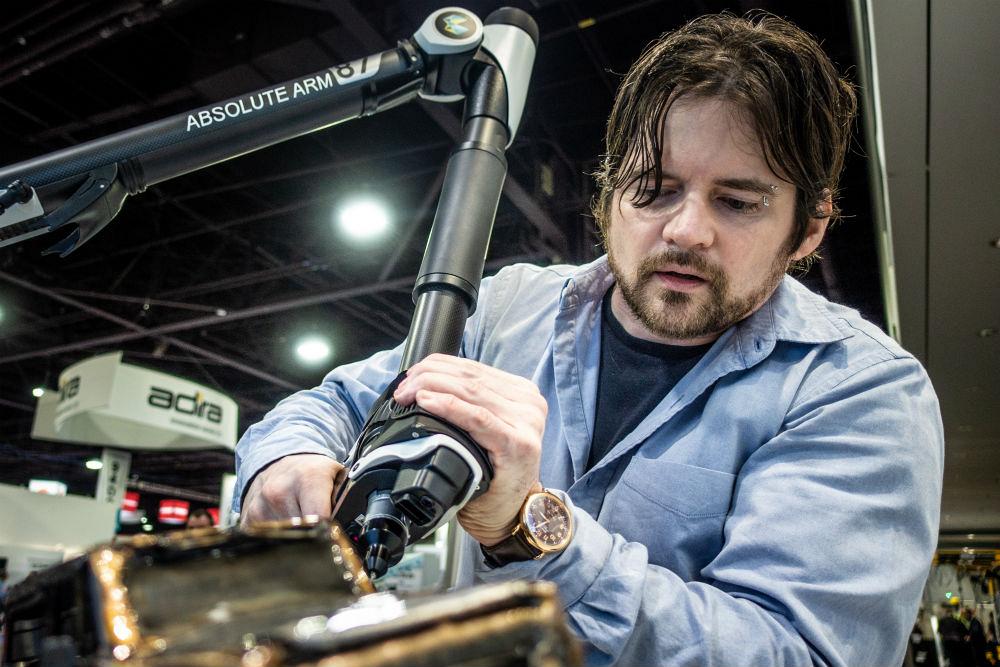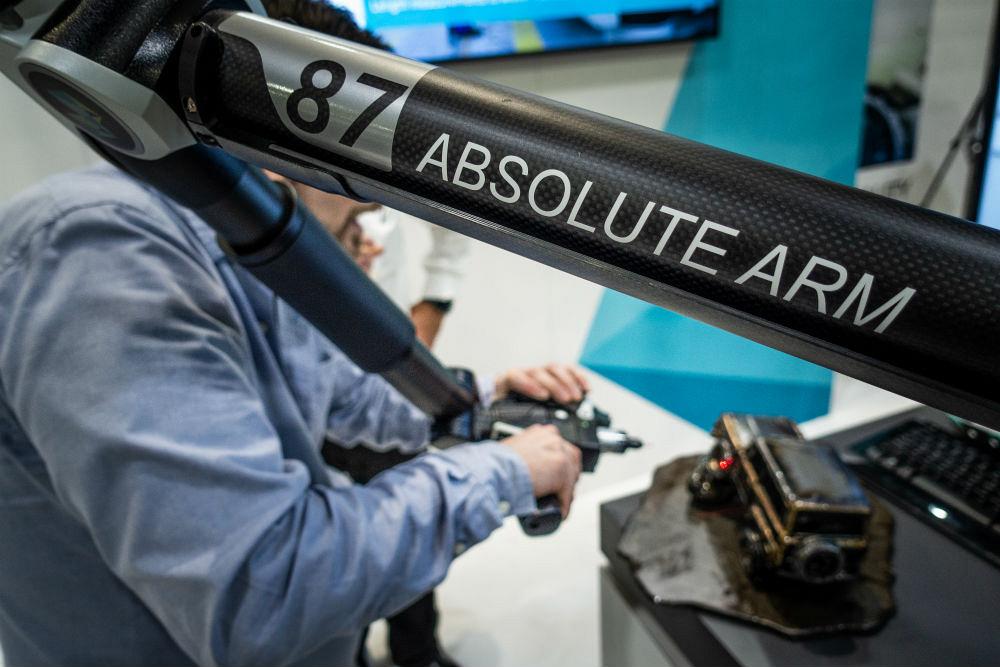Owner, Brown Dog Welding
- FMA
- The Fabricator
- FABTECH
- Canadian Metalworking
Categories
- Additive Manufacturing
- Aluminum Welding
- Arc Welding
- Assembly and Joining
- Automation and Robotics
- Bending and Forming
- Consumables
- Cutting and Weld Prep
- Electric Vehicles
- En Español
- Finishing
- Hydroforming
- Laser Cutting
- Laser Welding
- Machining
- Manufacturing Software
- Materials Handling
- Metals/Materials
- Oxyfuel Cutting
- Plasma Cutting
- Power Tools
- Punching and Other Holemaking
- Roll Forming
- Safety
- Sawing
- Shearing
- Shop Management
- Testing and Measuring
- Tube and Pipe Fabrication
- Tube and Pipe Production
- Waterjet Cutting
Industry Directory
Webcasts
Podcasts
FAB 40
Advertise
Subscribe
Account Login
Search
3D scanning: Making a metal fabricator's dream come true
Josh Welton uses Hexagon's Absolute Arm for 3D scanning during a live demonstration at FABTECH® 2018
- By Josh Welton
- December 27, 2018

Josh Welton of Brown Dog Welding teamed up with Hexagon at FABTECH 2018 in Atlanta to use 3D scanning technology on a metal structure.
As an artist who creates one-of-a-kind metal sculptures, I’ve struggled with ways to make the work more accessible to the masses. Photographic prints are cool, but the pieces don’t have the same impact in 2D form. I looked at the old masters who carved their sculptures with the intent purpose of creating molds to then cast them in bronze and thought it would be cool to mix old school with new tech to do something in that spirit.
To do that I hooked up with Hexagon Manufacturing Intelligence in Atlanta at FABTECH®. Actually, back that up; a few weeks before, I had a conference call with Hexagon engineers Phillip Lewis and Scott Grumbles about the process. While they explained to me, in very easy-to-understand terminology, how their scanning technology works, I realized how little I knew about 3D scanning. Because I work in prototyping and write for a trade publication, you’d think I’d be on top of that kinda thing, but I’m definitely late to the party.
Going even farther back, I had a conversation three or four years ago with my friend Jonathan Ward, who builds incredible custom vehicles through his company, Icon 4x4, in Los Angeles. One of the things he does on his resto-mod cars is 3D scan the underside of the old car to fabricate a modern frame and suspension specifically for that car. Motivated in part by my struggles with putting in the hours I did before the surgeries, he said, “We need to find you a way for you to make more money (with art) without having to make the same sculpture over and over.”
Painters, sketch artists, and photographers have had the luxury of scanning their work and selling much more affordable and readily available prints for a long while now; it’s difficult to make a living as an artist on original work alone. So we talked about making a mold and doing a limited run of bronze castings of a specific piece. The original model would retain its status as a one-of-a-kind sculpture, but now collectors could still get in the game, if that original piece was either spoken for or out of their price range.
One of many trends Jonathan is responsible for is the renewed popularity of the first-gen Ford Bronco. His version of the truck, the BR, costs well into the six-figure range, and enthusiasts line up for the chance to own one. I’d been wanting to do one for a while, and he thought an action shot of the BR articulating would make for a killer sculpture. Right away I had the concept in my mind of how that would look, and I knew that it would make for an interesting subject to cast later. So the Bronco has been the sculpture I’ve desired to climb this new branch with since before I made it.
Back to 2018. Hexagon had the idea for me to scan the sculpture live at FABTECH. To showcase different ways to capture the sculpture’s data, the engineers decided to use two methods from two different scanners. One of them was the AICON structured light system in which the Bronco was placed on a turntable that spins 360 degrees. I didn’t have to do anything but watch as the scanner did its thing, and the data showed up on the computer screen. It took less than 15 minutes to be completed. It’s a super-accurate, detailed setup, and one of the things that blew my mind was the color aspect. Phillip took pictures of the sculpture with his iPhone, imported them to the scanning program, and joined the images with the scanned data to show the 3D model of the piece in color!
The scanner I got to play with was Hexagon's Absolute Arm. I’ll let Scott explain the technical side: “The laser scanner on the Absolute Arm uses triangulation between the laser emitter, the object being scanned, and the camera system to determine the depth of each point projected onto the part. These depths, combined with the positional information provided from the arm’s absolute encoders, yield the position of the points in space, and with 752,000 points collected per second, those individual points combine to provide a digital image of the part. This image can then be further manipulated within the software to fill holes, remove flaws or defects within the part, or to smooth out a rough surface.”
I gripped the scanning gun at the end of the articulating arm and turned toward the sculpture. It had a trigger to activate and stop the data collection, and then a laser pointer to line up the scan line. The trick was to maintain a certain distance from the sculpture, which obviously has different depths and angles, while moving side to side. If I got in too close or too far away, the laser pointer would wander out of alignment in relation to the laser scan line. But, honestly, there was a lot of leeway; as long as I was in the ballpark, I could see the sculpture take shape on the screen. It was pretty effortless to move the gun anywhere it needed to be, no matter the direction. To show how easy it is to grab the data, I basically went into the event blind; I had no experience doing this sort of thing. It was as easy as they told me it would be, and way more fun than I anticipated. Seeing the virtual 3D Bronco grow on the monitor was thrilling. And it took minutes. I found myself searching for gaps in the model as an excuse to continue playing with the apparatus.
Each process worked perfectly well independently from each other, but you can actually merge the data to fill in any missing spots, or just add more detail. It’s not a necessity, but pretty cool to know that’s possible.
So now, thanks to Hexagon, I have the data necessary to 3D-print a replica of my sculpture. An added benefit is that I can scale it up or down, make it larger or smaller. I’m not sure exactly what I’m going to do next. Someone suggested printing it in wax to do a lost-wax casting. From talking to some vendors at FABTECH, it sounds like even just the cheap plasticky material often used in printing melts at a low enough temperature that it could take the place of wax. Out of curiosity I asked a rep how much it would cost to print in metal. “You don’t want to do that. You’re looking at $10k easy.” I don’t know how accurate that is, take it for what it’s worth.
The next step will be how to turn this model into a mold. Stay tuned . . .
(All photos courtesy of Hexagon, Nate Bowman, photographer.)subscribe now

The Fabricator is North America's leading magazine for the metal forming and fabricating industry. The magazine delivers the news, technical articles, and case histories that enable fabricators to do their jobs more efficiently. The Fabricator has served the industry since 1970.
start your free subscriptionAbout the Author

- Stay connected from anywhere

Easily access valuable industry resources now with full access to the digital edition of The Fabricator.

Easily access valuable industry resources now with full access to the digital edition of The Welder.

Easily access valuable industry resources now with full access to the digital edition of The Tube and Pipe Journal.
- Podcasting
- Podcast:
- The Fabricator Podcast
- Published:
- 04/16/2024
- Running Time:
- 63:29
In this episode of The Fabricator Podcast, Caleb Chamberlain, co-founder and CEO of OSH Cut, discusses his company’s...
- Industry Events
16th Annual Safety Conference
- April 30 - May 1, 2024
- Elgin,
Pipe and Tube Conference
- May 21 - 22, 2024
- Omaha, NE
World-Class Roll Forming Workshop
- June 5 - 6, 2024
- Louisville, KY
Advanced Laser Application Workshop
- June 25 - 27, 2024
- Novi, MI
































